Science (Latin scientia, “knowledge”) is “what we know to be learned, what we take to be true in a broad sense, all knowledge, study of universal value characterized by an object (field) and a specific method, and based on verifiable objective relations.“
The willingness of the scientific community, guarantor of science is to produce “scientific knowledge” from rigorous investigation methods, verifiable and reproducible. As for the “scientific methods” and “scientific values”, they are both the product and production knowledge tool and are characterized by their purpose, which is to help understand and explain the world and its phenomena in the most elementary way possible – to produce knowledge as close as possible to observable facts.
Unlike the dogmas that also claim to tell the truth, science is open to criticism and scientific knowledge and methods, are always open to revision. Moreover, science aims to understand the phenomena, and to draw accurate forecasts and functional applications; their results are constantly faced with the reality. This knowledge is the basis for many technical developments that have strong impacts on society.
Science is historically linked to philosophy. Dominique Lecourt writes that there is “a bond [uniting] science an particular mode of thinking that is philosophy. It is indeed because some thinkers in Ionia from the seventh century BC had the idea that one could explain natural phenomena by natural causes that have produced the first scientific knowledge. ” Dominique Lecourt explains that the first philosophers were led to do scientists (without the two are combined).
Science consists of a set of specific disciplines, each of which focuses on a particular area of scientific knowledge. This is for example mathematics, chemistry, physics, biology, mechanics, optics, pharmacy, astronomy, archeology, economics, or sociology, etc.
This categorization is neither fixed nor unique, and scientific disciplines can themselves be divided into sub-disciplines, also more or less conventional. Each of these disciplines is a particular science.
After a science TV show I decided to read books about science and find the best ones, after about 30 books and many Google searches, I was able to put a small list down for all the brainiacs out there.
6. Consciousness Explained
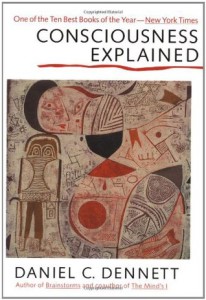
“Daniel Dennett is the Devil …” This exclamation Burton Voorhees, respectable professor of mathematics at Athabasca University, is perhaps somewhat exaggerated. But to consider the radicalism which demonstrated that it is, it is not excluded that it has a grain of truth…
The release of Sweet dreams in which Dennett answers some objections and began to dissipate philosophical dreams he considers to be at their root, provides an opportunity to revisit the thought of a crucial author.
The philosophical position of the author as stimulating as controversial are influenced by both the naturalism of WVO Quine, who argues that the key to the “spirit” can be understood and explained as any other natural phenomenon – “we are all made, he writes with his usual sense of provocation, robots devoid of mind and nothing more “- and by ordinary language philosophy (L. Wittgenstein, Austin J., G. Ryle …) which leads him to still take into account the particular way we formulate and interpret what happens in us.
Certainly, what we call consciousness seems the ineffable itself, “celebrated in the manner of a mystery situated beyond science, impenetrable from the outside“, so indoor and private experience that only the person involved would have access so that any company to explain it (philosophically or scientifically) fall wishful thinking.
Who else but me could have access to the qualitative dimension of what is happening in me, understand the precise feeling that gives me such a shade of blue, or know what I feel by eating marzipan or making love – in short: they know how it feels to be me?
This idea relates, generally, to the so-called dualistic assumption that the facts of consciousness (perceptions, beliefs, desires …) fall within a specific and separate order, which would not apply to ordinary laws governing the phenomena of the physical world, and therefore constitute, in the words of Spinoza, “an empire within an empire.”
“ We are nothing more than our brains ”
This is precisely the thesis that Dennett had to refute in a previous book, Consciousness Explained. He returns today, taking into account advances in neuroscience research. Its strategy is to tackle the main arguments mobilized in favor of the ineffable nature of consciousness or separated, in order to show the inconsistency.
Thus, to quote a famous thought experiment discussed by Dennett, imagine Mary, always isolated in the world, she would have known that through a black and white screen, but with an encyclopedic knowledge of available scientific data on the perception of color: there, Dennett argues the reverse of the prevailing opinion, no reason to assume that it will experience any wonder or the smallest surprise the day she will face for the first Once a colorful world “for real”.
He said the so-called unspeakable wealth that make up our conscious relationship to the world contains nothing more than what is likely to be described and explained by a neutral scientific discourse, conducting “a reasoned objective extrapolation from structures discernible in the behavior of subjects. ”
The most sensitive and perhaps the most difficult point to accept the Dennett’s theory is his criticism of what he calls the “Cartesian theater“. Namely the idea of a single, continuous point of view that coincide with what is called the conscience or the intimate experience, which would basically what I refer to when I use the words “I” , “I” …
Dennett attempts to demonstrate that there is no “total self” would be the disembodied spectator of our mental life, as there is not in the brain corresponding to single point a so-called “siege” of our thought or our personality, but only multiple streams of activity localized in very different areas of the brain.
“Celebrity Brain”
 But it is perfectly possible to admit that these processes and sub-processes specialized neural think for themselves without needing to be coordinated by a special entity that would correspond to our so-called me.
But it is perfectly possible to admit that these processes and sub-processes specialized neural think for themselves without needing to be coordinated by a special entity that would correspond to our so-called me.
At this Cartesian fiction of the self, Dennett substitute its model (Darwinian obedience) of the “cerebral celebrity”: instead of having to join it is unclear how privileged scene to become aware, cerebral content initially unconscious “can win something that looks more like what notoriety, in a fight with other content themselves in search of fame (or potentially poised to get it). ”
In the brain, no king or “official controller of programs on state television,” but the populations of neuronal machinery and machinic processes maintaining “more democratic, in fact some anarchists” relationships.
This implies at the same time (unlike, again, what Descartes supposed) that we paradoxically have no special insight into the knowledge of this which takes place “in” us a perspective “in third person “will be just as legitimate, and in some cases, more relevant.
In short, Dennett respond to the Socratic imperative Antique “Know thyself” requires to accept the idea, considered by many depressing yet pious minds, that we are nothing more than our brains … more illusions are our brains as to what they are.
5. The Blank Slate

Steven Pinker is a psychology professor at MIT. He is the author of numerous articles and two bestselling books: How the mind work and The Language Instinct (See thereon our article of January 5, 2001)
In his various writings, he developed the theories of evolutionary psychology, that it is necessary to refer mainly to the genetic evolution of the Darwinian mode to understand human nature.
In presenting the book differently and to simplify, we could say that The Blank Slate is a plea for sociobiology applied to the “reasonable” description of man and society. Sociobiology, it should not be confused with the outdated excesses of “genetics as everything” is to seek the legacies of biological evolution as it allowed the survival of animals and humans for millions, if not hundreds of millions of years.
These legacies still determine human behavior, the previously acquired education and culture and in a number of cases in conflict with them.For example, if it is true that a majority of children (if adult) today still feeling discomfort when they are alone at night, even when parents try to persuade them that they are not at danger.
Also, if they have never lived traumatic experience related to the darkness, we can assume that it is a hereditary acquired, because the darkness has always been their distant ancestors like animal lineages in which they descended, the place of all dangers. To express this, they used to say colloquially as fear of the night was a fear “instinctive”.
For a trait or behavior associated is transmitted from one generation to another without significant evolution, through different cultures, it must by definition it is controlled by a genetic gains. Just as the human genome provides for the transmission from one generation to the other physical characteristics that define the human (eg the lack of coat on the body), as it ensures the transmission of basic psychological behavior characterizing the human species.
If these physical characteristics and behaviors are under genetic control, this is because they permit the survival of individuals who were carriers and therefore the gene transfer thereof to their descendants. This does not also mean to these acquired characteristics are still appropriate today, survival in environments that have changed profoundly in recent years a few dozen. But it will not mean a cultural change by decree.
Genetics applied to anatomy poses little problem. It is relatively easy to show that such a gene or that gene locus is responsible for such anatomical detail, or such an anomaly. Things get complicated when it comes to physiology, that is to say organ function. Most often, it is easy to identify the genes responsible, directly or indirectly, major physiological mechanisms, particularly those contributing to the preservation of the integrity of an organism (homeostasis).
But many other factors interfere with these mechanisms throughout the life of the individual, for example microbial invasion or diet. They cause good or bad consequences that must be studied as such, although it remains that the body will react the fact from a genetically acquired base, such as the immune protection system.
The link between the genome and psychology is even more difficult to establish, as we study the individual or the society to which he belongs. One enters there in effect in the area of emotions, feelings and spirit. The first geneticists have caused scandal by saying that genes could play a role in how individuals perceive the world through the sensations and emotions, identifying descriptions that gave them spirit and ultimately how they built the social institutions.
It was there, it was thought, the exclusive domain of culture, that is to say that social relations between men produced beyond the biological, in increasingly diverse and complex societies including the humanities should inform laws. Today, geneticists and evolutionary psychologists (also called nativist or nativist), looking into the genetic evolution sources of the mainsprings of human psychology, learned to qualify the simplicity of their predecessors.
Except in special cases, they are looking for more “the” gene responsible for a particular behavior of a particular specificity of the character of this or that institutional construction. It is known that on the one hand the genes act most often in combination.
We know, moreover, that their action is often indirect, exercising throughout the development of the individual by chains of actions and reactions requiring cell functions increasingly diversified. Finally and above all we know that interactions between individuals generate (do emerge) the complexity according to laws that can not be deduced solely from the study of their genomes. This is also true for animals as well as humans. .
Thus, evolutionary psychologists are obliged them to take into account the influence of social life events on how individuals express the genetic basis of behavior. In animals and more so in man, life in society profoundly modulates genetic inheritances. The young are born with certain innate mechanisms that allow it to survive in the world during the first days, but if these devices do not interact with a complex physical environment they are deteriorating. This is what happens, for example, has long been known, in the sensory field. But it is the same devices ensuring the ability of the individual to life in society, that is to say, the relationships with others.
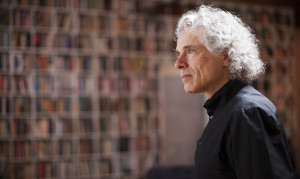 The best example is the ability to acquire and master the language. The brain is wired at birth (this is what Chomsky had said for 30 years). Some brain areas give the newborn, or even the embryo, a general aptitude for language (universal language), but the newborn should contact his mother and his entourage to his brain has appropriate connections to him and symbolic language communication within a given culture.
The best example is the ability to acquire and master the language. The brain is wired at birth (this is what Chomsky had said for 30 years). Some brain areas give the newborn, or even the embryo, a general aptitude for language (universal language), but the newborn should contact his mother and his entourage to his brain has appropriate connections to him and symbolic language communication within a given culture.
Life in society and can “specify” the bases of the emotional and spiritual life, providing role models that are imitated by individuals, at least if they match the genetic background and needs of specific survival for these individuals.
Generally used the term to denote epigenetic changes resulting from a continuous interaction between the genetic determinants of the individual and the emerging societal or cultural contributions within the group. It goes without saying that epigenetics must take account not only of the mutations occurring in the genomes, but those occurring on the classic Darwinian fashion, but with much faster rhythms, languages, organizations and cognitive contents (including the place méméticiens memes today). There are hardly any people nowadays, except rabid conservatives, who consider that companies express universals stable over time, common to all men and which do not touch.
Researchers, increasingly numerous, who continue to refer to sociobiology (starting with its founder EO Wilson) absolutely deny not the determining role of culture, considered as a set of constraints and opportunities arising from life individuals in society. But they refuse to consider this culture – or rather cultures – as outputs while armed with a development that would be specific to them, and requiring individuals regardless hereditary acquired them.
4. The Selfish Gene
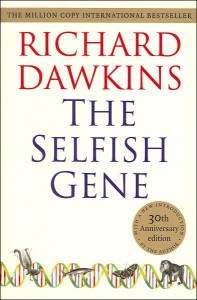
The Selfish Gene is a book about evolution written by Richard Dawkins, published in 1976. It is based on the theory of George C. Williams (described in the book Adaptation and Natural Selection). Dawkins coined the term “selfish gene” as a way to describe the evolution focused on the gene. Dawkins argues that central to the evolution of the gene is a better description of natural selection and the selection of organisms and populations never trumps the selection of genes.
We expect an organization to evolve to maximize its inclusive fitness (the number of copies of the genes that are transmitted). As a result, people tend to reach evolutionarily stable strategies. The author also invented the concept of meme as the unit of cultural evolution, analogous to the gene; this assumes that the selfish duplication can also be applied in human culture, in a different sense. Memetics has spawned numerous studies since the publication of the book.
Describing genes as “selfish”, the author does not mean there (as he states unequivocally in the book) they are provided with an own will or intention, but their effects can be described as if they were (see teleonomy). His thesis is that genes have established themselves in populations are those that cause effects that serve their own interests (that is to say, of continued propagation), and not necessarily the interests of the individual or even in some cases of its kind.
“ The book describe the evolution focused on the gene ”
This view explains altruism at the level of individuals in the wild, especially in the family: when an individual sacrifices himself to protect the life of a family member, it is in the interest of its own genes . Some people find this very clear metaphor, but its other misleading name, since pretend confer cognitive attributes to a purely causal process. For example Andrew Brown wrote:
“Selfish”, applied to the gene does not mean “selfish” at all. This means in fact an extremely important quality for which there is no right word in English: “the ability to be copied by a Darwinian selection process. “It is a complicated term and extension. Perhaps there is a better and more short-term – but it’s not “selfish” .
Dawkins’s book, however, was a bestseller, without provoking violent controversies of the previous book Sociobiology Wilson who nevertheless expressed a similar vision.
3. Arcadia
Arcadia is a play by Tom Stoppard. The first was held in London April 13, 1993 at the Royal National Theatre. The piece has since been performed in many theaters. It had an extraordinary critical reception; the critic of the London Daily Telegraph wrote: “I’ve never been more convinced outgoing year a play that I had just seen a masterpiece.” It won the Olivier Award for best play in 1993, and also the New York Drama Critics Award for 1995. The title of the work refers to the Latin phrase Et in Arcadia ego, and this underlines the gravity of comedy.
The plot of Arcadia framework for an English house, Sidley Park, and the action takes place alternately in 1809 and 1989, frequently passing from one era to another. The piece noted scholars of the present day (writer, academic, student …) during their research, juxtaposing their interpretations of clues left by the inhabitants of the nineteenth century and the indices themselves. Arcadia explores the nature of the “evidence” and truth in the context of modern ideas of mathematics and physics. The play asks questions of modernity of power, and she satirizes postmodern motivations; at the ending, in a monologue, a character defends beauty and totality of the universe according to Aristotle.
In 1809, Thomasina Coverly, a teenager whose ideas in mathematics and physics are way ahead of its time (the room is exposing him especially the notions of entropy and chaos theory), studying with his tutor Septimus Hodge, friend of Byron.
In 1989, two experts in their respective fields – Hannah Jarvis, a historian who is researching a hermit who lived there, and Bernard Nightingale, a professor of literature who comes to reveal a secret chapter in the life of Byron – come to Sidley Park. During their investigations, aided by research biologist Valentine Coverly gradually we discover what really happened in 1809.
The original production of 1993 was directed by Trevor Nunn. The cast included Rufus Sewell in the role of Septimus Hodge, Felicity Kendal (Hannah Jarvis), Bill Nighy (Bernard Nightingale), Emma Fielding (Thomasina Coverly), Alan Mitchell (Jellaby), Derek Hutchinson (Ezra Chater), Sidney Livingston (Richard Noakes), Harriet Walter (Lady Croom), Graham Sinclair (Captain Edward Brice RN), Harriet Harrison (Chloe Coverly), Timothy Matthews (Augustus Coverly / Gus Coverly) and Samuel West (Valentine Coverly).
The first Broadway took place at Vivian Beaumont Theatre in March 1995. The director was again Trevor Nunn, but the distribution was completely different: Billy Crudup (Septimus), Blair Brown (Hannah), Victor Garber (Bernard) Robert Sean Leonard (Valentine), Jennifer Dundas (Thomasina), Paul Giammati (Ezra Chater), Lisa Banes (Lady Croom), Richard Clarke (Jellaby), John Griffin (Gus / Augustus), Peter Maloney (Noakes), David Manis ( Captain Brice, RN) and Haviland Morris (Chloe). This production received a nomination for the Tony Award for Best Play in 1995.
2. King Solomon’s Ring
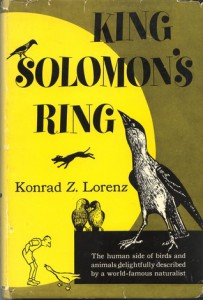
Lorenzo, Zacharias Konrad (Lorenz, Konrad Zacharias) (1903 to 1989), is an Austrian ethologist and naturalists zoopsychologists, awarded in 1973 the Nobel Prize in Physiology or Medicine (jointly with K.Frishem and N.Tinbergenom) for the study of individual and animal behavior group. Born November 7, 1903 Vienna.
He graduated from New York and Vienna University in 1933, received his PhD in Zoology at the University of Munich. From 1937, he taught comparative anatomy and zoopsychology the University of Vienna, and in 1940 he became a professor of psychology in the University of Königsberg.
During World War II, he served as a military surgeon in the German army in 1944-1948 and was a prisoner in the Soviet Union. Returning to Vienna, he taught at the university and has studied the behavior of animals.
In 1949 he wrote King Solomon’s Ring, a zoological book for a large audience, but the first english translated book appeared in 1952. The book was named after the Seal of Solomon, an object that gave the power to communicate with animals. He explains in the book the refined social system he discovered for the Eurasian Jackdaw, the tiny water shew and the interactions of unintelligent smal fish.
The book points out several misconceptions about how intelligent animals are and their similarities with humans. King Solomon’s Ring also explains the issues that pets bring, Lorenz listes the benefits that pet owners get from pets but also the hazards that animals bring to inhabitants and that pet captivity can make it difficult, explaining how to avoid these situations.
1. The Periodic Table
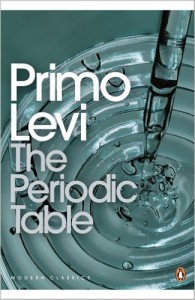
The Periodic Table is a collection of short stories by Primo Levi, published in 1975. On the eve of his retirement from the world of chemistry in order to concentrate on his writing career, Levi wrote, 21 chapters, each carrying the name of a chemical element, under the signs of which it placed his life and tried to find an answer to questions of the universe, by confronting the matter directly, friendly, indifferent or hostile.
Chemistry has in turn influenced his writing, introducing the analysis and objective description, the need to clarify the sources of problems to resolve and the constant questioning of prior learning.
Despite the reference to the periodic table of Mendeleev’s periodic system it’s not so much a chemistry book as it is about chemist, an Italian Jew of Piedmont, fighting against fascism, deported and then witness and writer, telling “his” chemistry. Levi plays with the elements, which can be cited literally when they intervene directly in the account of the new, or even figured etymological.
The stories span the author’s life, from his birth to writing the book, stopping on essential moments and trainers: the origins, purpose, the formative years, the rise of fascism and racial laws, life in hiding, the arrest of Primo Levi, the concentration camp experience, rehabilitation to life, confrontation with former players of the past and work experiences, all under the prism of chemistry; most of the stories are lived, some are fictions of the author and marked as such. Each story has the name of an element associated with it one way or another, my favorite one being Vanadium.
The book was inducted best science book ever by the Royal Institution of England in 2006.

